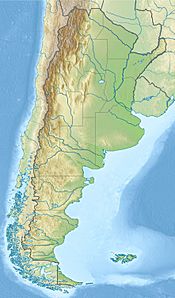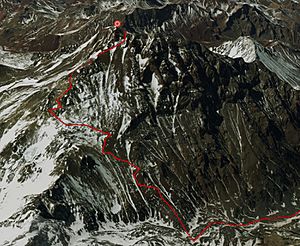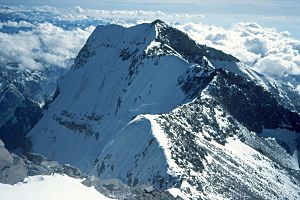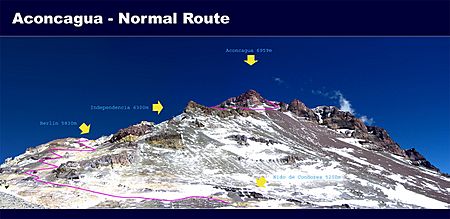Aconcagua facts for kids
Quick facts for kids Aconcagua |
|
|---|---|
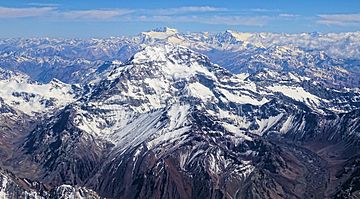
Aconcagua from the south
|
|
| Highest point | |
| Elevation | 6,960.8 m (22,837 ft) |
| Prominence | 6,960.8 m (22,837 ft) Ranked 2nd |
| Listing | |
| Naming | |
| Pronunciation | or |
| Geography | |
| Country | Argentina |
| Province | Mendoza |
| Parent range | Principal Cordillera, Andes |
| Climbing | |
| First ascent | 1897 by Matthias Zurbriggen (first recorded ascent) |
| Easiest route | Scramble (Northwest) |
Aconcagua is a giant mountain in the Andes mountain range, located in Mendoza Province, Argentina. It is the tallest mountain in the Americas. It is also the highest mountain outside of Asia and the highest in the Southern Hemisphere. Its top reaches an amazing 6,961 metres (22,838 ft) into the sky.
Aconcagua is about 112 kilometres (70 miles) northwest of the city of Mendoza. It is also close to San Juan Province and Argentina's border with Chile. This mountain is one of the famous Seven Summits, which are the highest mountains on each of the seven continents.
The mountain is surrounded by two valleys: the Valle de las Vacas to the north and east, and the Valle de los Horcones Inferior to the west and south. Aconcagua and the areas around it are part of the Aconcagua Provincial Park. The mountain has several large glaciers. The biggest one is the Ventisquero Horcones Inferior, which is about 10 km (6 mi) long. It flows down from the south side of the mountain. The Polish Glacier on the northeast side is also very well known, especially for climbers.
Contents
What Does the Name Aconcagua Mean?
The exact meaning of the name Aconcagua is not fully known. It might come from the Mapudungun language, where Aconca-Hue means "comes from the other side."
Other ideas suggest it comes from the Quechua language. Ackon Cahuak could mean "Sentinel of Stone," or Anco Cahuac could mean "White Sentinel." In the Aymara language, Janq'u Q'awa means "White Ravine."
How Aconcagua Was Formed
Aconcagua was created by huge forces deep within the Earth. It happened when the Nazca Plate slowly slid under the South American Plate. This process is called subduction.
Millions of years ago, Aconcagua was an active stratovolcano. This means it was a cone-shaped volcano that erupted many times. Over time, the way the plates moved changed. This caused the volcano to stop erupting and instead, the land was pushed up. This is how Aconcagua grew into the tall mountain we see today. The rocks on Aconcagua's sides are mostly volcanic, like hardened lava and other volcanic materials.
Climbing Aconcagua
Climbing Aconcagua from the north side, using the "normal route," is considered technically easy for a mountain of its size. It doesn't usually require special ropes or ice axes. Because of this, Aconcagua is often called the highest "non-technical" mountain in the world.
However, the high altitude makes climbing very challenging. The air at the top has only about 40% of the oxygen found at sea level. Most climbers will feel some effects of altitude sickness. Even though the climb is not technically hard, many people get hurt or even die each year. This is because many climbers don't realize how dangerous the high altitude and very cold weather can be. Cold weather injuries are quite common near the summit.
Routes from the south and southwest sides are much harder. The south face climb is known for being very difficult. Another popular way to climb is the Polish Glacier Traverse route. This route crosses the Vacas valley and then joins the normal route for the final climb to the top.
Park rangers don't keep exact records of how many people reach the summit. But it's thought that about 30–40% of climbers make it to the top. Most climbers are from other countries, with the United States, Germany, and the UK sending the most people. About 54% of climbers use the Normal Route, and 43% use the Polish Glacier Traverse Route.
Climbing Camps on Aconcagua
Along the normal climbing route, there are several camps where climbers can rest and get used to the altitude. Here are some of them:
- Puente del Inca, 2,740 metres (8,990 ft): This is a small village on the main road. It has places to stay and other services.
- Confluencia, 3,380 metres (11,090 ft): This camp is a few hours walk inside the national park.
- Plaza de Mulas, 4,370 metres (14,340 ft): This is the main base camp. It's said to be the second largest base camp in the world, after Mount Everest's. It has food tents, showers, and even internet. A medical team checks climbers here to make sure they are healthy enough to keep going.
- Camp Canadá, 5,050 metres (16,570 ft): A large flat area with great views of Plaza de Mulas.
- Nido de Cóndores, 5,570 metres (18,270 ft): This is a large plateau with wide views. A park ranger often stays here.
- Camp Berlín, 5,940 metres (19,490 ft): This is a classic high camp that offers good protection from the wind.
- Camp Colera, 6,000 metres (19,690 ft): This camp is larger and becoming more popular. It's located near Camp Berlín. In 2011, an emergency shelter named Elena was opened here.
Climbers usually start their final push to the summit from one of the high camps like Berlín or Colera.
History of Climbing Aconcagua
The first known attempt by Europeans to climb Aconcagua was in 1883. A German explorer named Paul Güssfeldt led a group. He tried to reach the top from the northwest side and got as high as 6,500 metres (21,300 ft). The path he explored is now the standard route.
The first recorded time someone reached the summit was in 1897. This was part of a British expedition led by Edward FitzGerald. FitzGerald himself didn't make it to the top after many tries. However, the expedition's guide, Matthias Zurbriggen from Switzerland, successfully reached the summit on January 14, 1897. A month later, two other team members, Stuart Vines and Nicola Lanti, also reached the top.
The east side of Aconcagua was first climbed by a Polish team in 1934. They climbed what is now called the Polish Glacier. The very difficult South Face was conquered by a French team in 1954.
As of 2020, the youngest person to climb Aconcagua is Tyler Armstrong from California. He was nine years old when he reached the summit in 2013. Kaamya Karthikeyan from India became the youngest girl to reach the summit in 2020 at age 12. The oldest person to climb it was Scott Lewis, who was 87 years old in 2007.
In 2014, Kilian Jornet set a record for climbing and descending Aconcagua from Horcones in 12 hours and 49 minutes. This record was broken less than two months later by Karl Egloff, who did it in 11 hours and 52 minutes. The women's record is held by Daniela Sandoval, who completed it in 20 hours and 17 minutes.
In 2019, an Airbus Helicopters H145 helicopter landed on the very top of Aconcagua. This was the first time a twin-engine helicopter had landed at such a high altitude. The trip from Mendoza to the peak took about 45 minutes.
Dangers on Aconcagua
Aconcagua is nearly 7,000 m (23,000 ft) high, making it the tallest peak outside of Asia. It is known to have a high death rate compared to other mountains in South America, with about three deaths each year. This has given it the nickname "Mountain of Death." More than 100 people have died on Aconcagua since records began.
Another challenge on the mountain is dealing with human waste. Because of improper disposal, there are health risks for both animals and people. Climbers are encouraged to use special eco-friendly toilets, which are often provided by organized expeditions. Large amounts of waste are flown out by helicopter each climbing season.
Aconcagua's Meaning to the Incas
For the ancient Incas, Aconcagua was a very special and sacred mountain. Just like on other important mountains, the Incas built places of worship here. They also performed sacrifices, including human sacrifices.
In 1985, amazing sites were discovered at an elevation of 5167 meters. These are among the highest Inca sites ever found and are very difficult to reach. At one site, the remains of a child were found. The child was resting on grass, cloth, and feathers inside stone walls. This discovery is known as the Aconcagua mummy. The child's clothing showed that they were from a very important family. Other items found included small figures and coca leaves.
|
See also
 In Spanish: Aconcagua para niños
In Spanish: Aconcagua para niños


